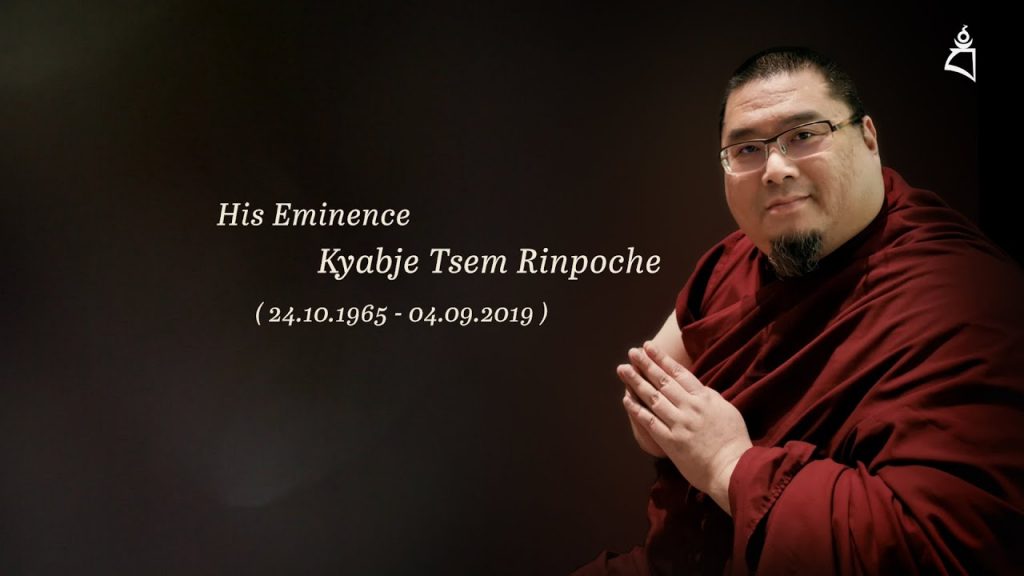Biography
H.E. Tsem Rinpoche was a world-renowned Buddhist teacher, the 25th incarnation from a long line of Indian, Nepali and Tibetan Buddhist masters dating back to over 2500 years ago. He was the founder of the Kechara Buddhist Organisation headquartered in Malaysia, a prolific author of commentaries, discourses and books on Buddhism, and a beloved spiritual guide to many disciples around the world. He dedicated his entire life to the practice and proliferation of Buddhism especially through the digital world.
In a Buddha’s footsteps
An abridged biography of H.E. the 25th Tsem Rinpoche
His Eminence Tsem Rinpoche Jetsun Tenzin Zopa Yonten Gyatso, the unparalleled asset of the Gelug tradition and a long-time Dharma brother of pure spiritual bond…
– His Holiness Kyabje Trijang Chocktrul Rinpoche
“What do you want to be when you grow up?” Most children’s answers vary little, falling along the lines of firefighter, policeman, doctor, astronaut or engineer. For His Eminence the 25th Tsem Rinpoche, that answer was very, very different.
Rinpoche was an unusual child, to say the least. Monks in Howell, New Jersey (USA), where Rinpoche grew up, remember a young boy who spent hours staring at the altar, memorising every single detail of each Buddha. While other children played outside, Rinpoche followed the monks around the temple asking countless questions. And while other children longed to visit the mall to hang out with their friends, Rinpoche liked nothing better than to sit inside the prayer hall to recite mantras for hours upon hours.
The monks also remember a young boy who was simultaneously mischievous and cheeky but very kind, who read voraciously, borrowing hundreds of books to absorb every bit of Dharma he could get his hands on. He had an incredible memory for the Buddha’s teachings; however complicated the subject, he only needed to be taught once and he would remember it forever. To some it would appear that this was not knowledge being acquired afresh, but a recollection of what had already been accomplished in past lives.
And most of all, the monks remember a young boy who instinctively showed an unusual level of devotion to his first guru (teacher), His Eminence Kensur Rinpoche Lobsang Tharchin, an abbot of one of the greatest Tibetan Buddhist monasteries in South India. This depth of guru devotion, which arose spontaneously, would come to be a defining feature for the rest of Rinpoche’s life.
Yet, despite Rinpoche’s tremendous Dharma qualities, life back then was not so simple. In comparison to other ‘golden children’ who were recognised as reincarnations from a young age, Rinpoche did not have an easy childhood. It was an upbringing marked by abandonment, violence and loneliness, in an environment far removed from the one he desperately longed to be a part of, the monastery.
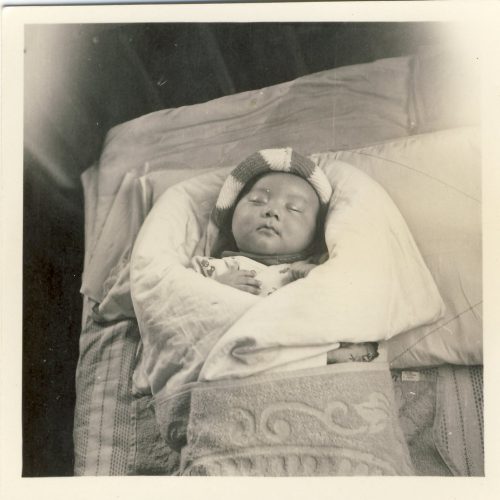
Rinpoche’s journey in this life began in Taipei, Taiwan where he was born on October 24, 1965 to a Mongolian mother and Tibetan father. His father, Lobsang Gyatso, was a former monk living in Taiwan and working for His Holiness the Dalai Lama, while his mother Dewa Nimbo was a princess descended from the lineage of Genghis Khan. Unbeknownst to her however, Rinpoche’s father was already married, with a family of his own in Tibet. Because Rinpoche was born out of wedlock, his mother gave him up for adoption, unable to bear the shame and stigma of having an illegitimate child.
Even from such a young age, there were already signs that this was no ordinary baby. Every single night while she was pregnant with Rinpoche, Princess Dewa dreamt of a baby white elephant entering her courtyard and she would tie it to a tree. It is an event that harkens back to the experience of Queen Maya who, while pregnant with her son Siddhartha Gautama, dreamt of a white elephant entering her womb. Siddhartha would later arise to become the Lord Buddha; Rinpoche would later become one of the foremost propagators of Vajrayana Buddhism in South East Asia.
On the day Rinpoche was born, Princess Dewa dreamt of high lamas performing pujas in her home, heralding the coming of a great being or Dharma king. The delivery itself was an easy, painless one; in a Buddhist context, this is taken to be the sign of a bodhisattva, a supramundane being who is characterised by their immeasurable compassion and spontaneous wish to always benefit others, whose existence causes no suffering to anyone, even the mother who gives birth to him.
Indeed, Rinpoche always sought to take pain away from people, whether physically via initiatives like Kechara Soup Kitchen or spiritually through disseminating the precious Dharma. Thus, on learning of the circumstances leading up to and during his birth, it becomes clear that Rinpoche’s bodhisattva nature, already accomplished from countless previous lifetimes of practice, had manifested in this lifetime from a very early age, in fact from the moment of his birth.
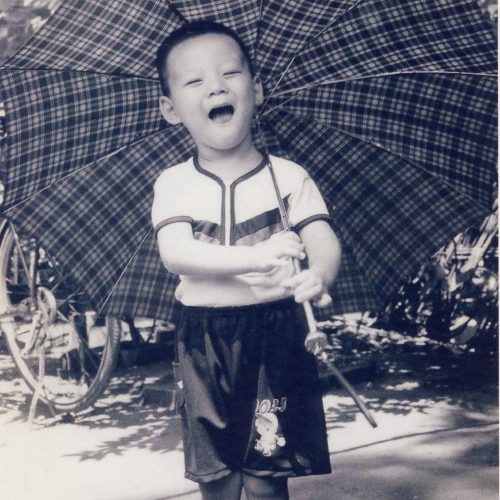
Born Prince Iska Minh, Rinpoche was a mere seven months old when the first semi-official recognition came of his special qualities. This would repeat itself throughout his life in Los Angeles, South India and Nepal until Rinpoche was formally recognised and enthroned on May 31, 1990 at the age of 24.
In more ways than one, Rinpoche’s life story echoes that of Lord Buddha, and not just because of the auspicious dreams heralding his birth. Just as holy men once predicted for King Suddhodhana that his son Siddhartha would become a Buddha, in Taipei the monks who came for Prince Iska recognised him as a high lama. They requested Princess Dewa for permission to take him to the monastery. His admission, however, would require her to reveal the child’s father to the monastic administration. Hurt by her ex-lover’s betrayal and reluctant to divulge his identity, she declined their request, saying that if the child was really who they said he was, he would one day find his way back to the monastery.
Little did she know how her decision would affect the rest of his life. It would be decades before Rinpoche returned to the monastery, just as it was decades before Siddhartha left the palace in his search for Enlightenment, after his father King Suddhodhana refused to accept the holy mens’ prediction for him.
However, unlike Siddhartha whose father used wealth and luxury to try and distract his son from his spiritual quest, Rinpoche’s upbringing was quite the opposite. After a difficult childhood in Taiwan, Rinpoche was adopted to Howell in New Jersey, USA at the age of seven. It was 1972 when he arrived in the home of a Kalmyk-Mongolian family who would become his adoptive parents for the next 10 years. Renamed Burcha Bugayeff, life there did not improve very much as the physical abuse continued. However, Rinpoche now had the benefit of living just 10 minutes away from Rashi Gempil Ling, one of the first Tibetan Buddhist temples in North America. It was at Rashi Gempil Ling where Rinpoche would meet his first guru, His Eminence Kensur Rinpoche Lobsang Tharchin.
Throughout his life, Rinpoche always displayed an irrepressible and insatiable thirst for the Dharma. This clearly manifested in New Jersey, where he scoured the libraries looking for books on Buddhism. Considering this was the 1970s in a small, rural American town, it was no easy feat. If he found any images of the Buddhas, Rinpoche would photocopy them for his altar at home. He would draw and paint the Buddhas as well, creating pendants then pretending to bless them, before gifting them to his friends and cousins – even from such a young age, Rinpoche knew intuitively that Buddha pendants would protect and bless the wearer.
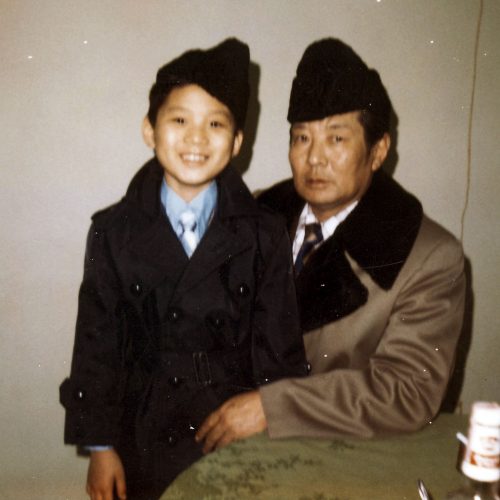
All of Rinpoche’s Dharma activities however, had to be kept a secret because if his parents found out, severe beatings and punishments would swiftly follow. Rinpoche’s parents already had a life path mapped out for their only son – go to school, go to college, get a job, get married, buy a house and give them grandchildren. It was, to them, the American Dream and one that would reflect their success as immigrants and parents. The only problem was that their American Dream was at total odds with their child’s, who only wanted to grow up and don the maroon robes as he had so often done in his previous lives.
Undeterred by their threats and punishments, Rinpoche pressed on, finding any excuse to go to the temple and prolong his time there. Whether it was mowing the lawn, washing dishes or tidying up the prayer hall, Rinpoche would do it without being told to do so, intuitively assuming the age-old Buddhist practice of serving his guru even if it meant risking a violent beating once he got home. Rinpoche’s students would later recognise this same determination as the driving force behind his benefitting others, using any and all means to assist them, even if it came at great personal cost.
Rinpoche’s fellow Dharma students from that time also witnessed that determination and recall a joyful, intelligent child with a natural interest in the Dharma, who immediately understood even the most subtle teachings. Later, as a teacher himself, Rinpoche would become known for his ability to convey complex Buddhist philosophies in simple, layman’s terms; signs of this first manifested in Rashi Gempil Ling, when grown adults would seek out the teenage Rinpoche to explain what Kensur Rinpoche taught. This trend followed him to Los Angeles, where he ran away to at the age of 16 after the abuse at home in New Jersey became intolerable and had begun to threaten to curtail his Dharma practice.
1980s Los Angeles was a wild town, ruled by the mantras of hedonism and materialism. It was a true modern-day version of the palace of distractions King Suddhodhana had once created for Siddhartha to try and stave off his inevitable enlightenment. Still, though the odds were stacked against him, Rinpoche was once again drawn to the Dharma, driven by the power of vows made in his previous lives to benefit sentient beings. It was in this desert nearly devoid of spiritual practice that Rinpoche met his second guru, Venerable Geshe Tsultim Gyeltsen as well as the lama who would profoundly change his life, his root guru His Holiness Kyabje Zong Rinpoche.
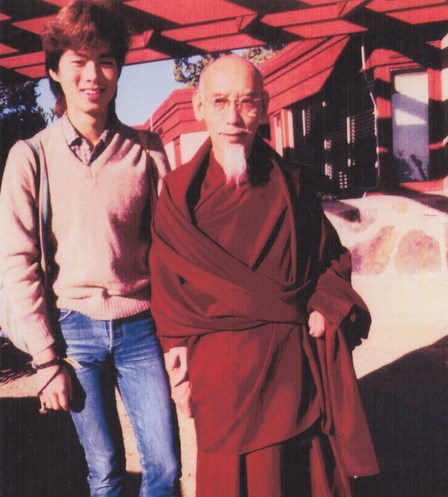
Under the tutelage and nurturing of these two masters of sutra and tantra, Rinpoche’s reconnection to the practices of his previous lives accelerated exponentially. Over six months in 1983, Kyabje Zong Rinpoche transmitted to Rinpoche the main practices and teachings that Rinpoche would continue to carry for his entire life, including that of the Dharma Protector Dorje Shugden. And it was to Kyabje Zong Rinpoche whom Rinpoche made a promise to become a monk; upon accepting the promise, Zong Rinpoche offered Rinpoche a place to stay in Zong Ladrang (his private office and household).
This promise was fulfilled in December 1987, with Rinpoche’s arrival in Gaden Shartse Monastery, South India. The past few months had been spent in Nepal and Dharamsala in North India, where Rinpoche had received his monk ordination vows from His Holiness the 14th Dalai Lama. Rinpoche’s arrival in Gaden however, was bittersweet – by this time, Kyabje Zong Rinpoche had passed away so Rinpoche would be joining Zong Ladrang without his beloved teacher there. Despite the pain of being without his guru, Rinpoche kept his promise and entered Gaden, furthering his monastic training under some of the most renowned teachers and philosophers of the day.
Physically, life in the monastery was tough. Without a sponsor, Rinpoche had barely any food to eat. There was no running water and his room with a leaky roof was right next to a cowshed. Still, although India lacked all of the modern comforts of America, Rinpoche remained sanguine. Never mind the physical challenges – he was finally in the place he had always dreamed of. Amidst a sea of shaven-headed pandits all striving towards the final goal of Enlightenment, he had never been happier.
Although Rinpoche himself was starving, his generous nature never left him. Monks often saw Rinpoche sharing his meagre rations with birds and stray dogs. Never once did Rinpoche complain; many years later, Rinpoche’s students only learned about these difficult times through photographs taken at the time.
It was also in Gaden where Rinpoche, despite not having any sponsors of his own, would spearhead many charity initiatives, raising millions for the monks as well as the Tibetan refugee and local Indian communities. These funds went towards, amongst other things, installing water pumps, paying for medical treatment, buying cows and buffaloes to provide milk for the monks, sponsoring school fees for poor families, sponsoring old folks’ homes, schools and community halls, as well as feeding the poor.
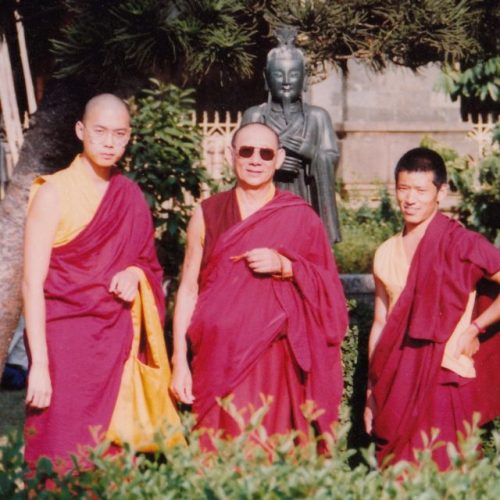
In addition to raising funds, Rinpoche also attended his classes, sat on the monastery’s education committee and served as his guru Kensur Rinpoche Jampa Yeshe’s secretary while Kensur Rinpoche was abbot. Later on, Rinpoche was unceasing in his efforts to get Kensur Rinpoche’s diabetes under control, an act that has been singularly credited with saving Kensur Rinpoche’s life.
Older monks who were in the monastery back then recall Rinpoche’s efforts with much gratitude; for many of them, Kensur Rinpoche was their main philosophy and scripture teacher, and therefore the source of all their learning, qualifications and attainments. It was thanks to Kensur Rinpoche tirelessly turning the Wheel of Dharma that these monks became some of the most highly respected teachers today. This would not have happened without Rinpoche there to address Kensur Rinpoche’s diabetes; there is no doubt Kensur Rinpoche would have passed prematurely, leading to an irreplaceable loss of knowledge, wisdom and learning.
Through all of this, life physically continued to be very difficult for Rinpoche. However, as with all things related to serving the Sangha, things soon fell into place so that Rinpoche’s living conditions would improve. It was during these years in the monastery that Rinpoche reconnected with his birth father who, during one Tibetan New Year, begged for Rinpoche’s forgiveness. Lobsang Gyatso apologised for the suffering Rinpoche had endured as a result of being given up for adoption. As a former monk himself, he recognised the purity of Rinpoche’s vows, the depth of his practice as well as his unwavering devotion to his teacher and determination to serve Gaden Shartse. Impressed, Lobsang Gyatso later became one of Rinpoche’s main sponsors.
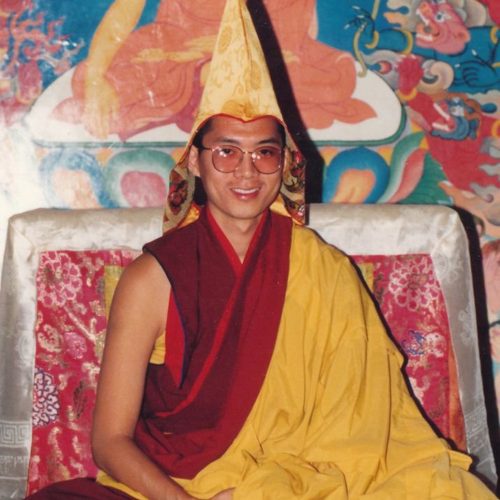
Not only was there finally an end to the near-starvation Rinpoche had endured but when Rinpoche was finally recognised and enthroned as a high lama in 1990, his father also sponsored his son’s entire enthronement ceremony. Lobsang Gyatso’s generosity later extended to sponsorship of Rinpoche’s new home. The construction of Tsem Ladrang put an end to Rinpoche’s stay in the leaky cowshed but true to his deep guru devotion, Rinpoche immediately offered up his new two-storey home to his guru Kensur Rinpoche Jampa Yeshe.
But a bodhisattva never rests for long and as with so many other moments in Rinpoche’s life, this idyllic time soon came to an end. In 1992, a huge influx of monks arrived from Tibet. Without adequate housing to accommodate them, they were forced to sleep outside on the verandahs. Being the monsoon season, many soon contracted tuberculosis or fell victim to snakebites. The urgent and pressing need to develop monks’ quarters led Rinpoche to travel to Malaysia, a journey undertaken at the instructions and blessings of his gurus His Eminence Kensur Lati Rinpoche and Kensur Rinpoche Jampa Yeshe, as well as Rinpoche’s Dharma Protector Dorje Shugden.
That is not to say Rinpoche was happy about leaving. It had taken him years to finally make his way back to the monastery, a journey that had begun over two decades ago when Princess Dewa first refused to allow monks to bring him to the monastery. And just as he had been adopted away from Taiwan, forced to run away from New Jersey, and had left Los Angeles to move to India, Rinpoche was once again having to leave a place he had come to think of as his home.
Yet, it was his sense of duty to the monks, as well as his devotion to his gurus and Dharma Protector that prevailed. Young, fluent in English and already proficient in the texts and scriptures, Rinpoche’s gurus stated their case – there was no one else more suited to the task than the young Tsem Rinpoche. And so setting aside his own wish to retreat deep into the Himalayan mountains and engage in meditation practices, Rinpoche packed two suitcases and departed India. In one bag were clothes and books; in the other were protection amulets and blessed items to distribute to the laity. Landing in Malaysia, Rinpoche embarked on a nationwide tour, meeting thousands of people as he fulfilled hundreds of teaching engagements and performed countless blessings.
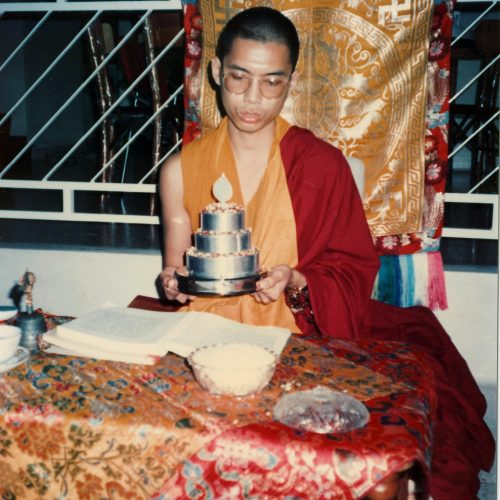
Rinpoche had never heard of Malaysia until he arrived in India, where he had met a few Malaysian Buddhists on pilgrimage. So his knowledge of the South East Asian country was limited; to him, anywhere that was not the monastery simply did not interest him. To Rinpoche’s pleasant surprise however, he was extremely well-received. He had had no idea so many Malaysians were Buddhist and they, in turn, immediately took to the young monk.
As Rinpoche continued his tour of Malaysia, word began to spread of this young Tibetan lama who was simultaneously witty and philosophical; who dispensed advice that was realistic, practical and showed an understanding of the challenges people face in their everyday lives; who counseled them tirelessly and who taught in fluent English.
Rinpoche also developed the reputation of being a highly skilled ritual master, adept in providing healing, or even dispelling black magic and spirits. He also became popular for his divinations; those who were precise in following his divination advice found that whatever he predicted was accurate and whatever remedy he told them to apply was effective. Difficult situations were resolved, diseases and ailments were healed, relationships were mended and careers progressed.
Above all, those who met the young Rinpoche were impressed by how earnest and sincere he was in his wish to benefit others. Hence before long, donations started to come in, contributed by the faithful and grateful.
Rinpoche’s triumphant return to Gaden just three months later saw him accompanied by some Malaysian students. In front of the entire community of thousands of monks, Rinpoche offered up all of the funds needed to construct an entire block of monks’ quarters. Just like that, the monastery’s accommodation problem was gone. Overjoyed, his gurus Kensur Lati Rinpoche and Kensur Rinpoche Jampa Yeshe wept during the ceremony because now no more monks would fall ill or be bitten by snakes.
But the people Rinpoche connected with in Malaysia could not forget him. In the succeeding years, an increasing number visited Rinpoche in India, requesting him to return to their country. Rinpoche’s connection with Malaysia continued to strengthen and grow until 2004, when Kechara House Buddhist Association Malaysia was established to further Rinpoche’s vision and works.
Under Rinpoche’s guidance, the Dharma was no longer dry theory confined to the interests of academics and scholars, or abstract esoteric concepts appealing only to hippies or New Age spiritualists. Under Rinpoche’s guidance, the Dharma came to life, leaping from the pages of books and manifesting in larger-than-life form. Experiential learning swiftly became Rinpoche’s trademark, thanks to his ability to show how Dharma could be both applicable and relevant in the 21st Century.
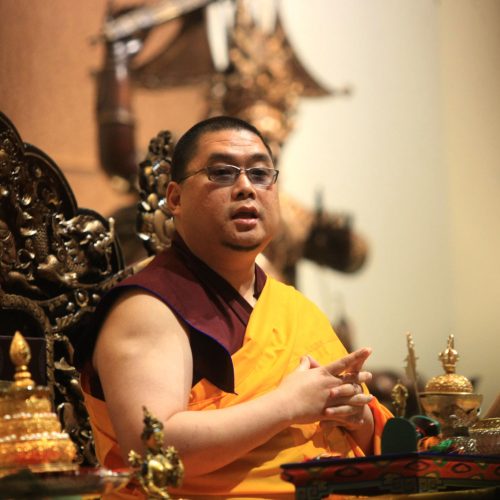
And not only did Rinpoche continue serving the public in the same way he had on his first trip to Malaysia but true to his bodhisattva nature, Rinpoche took it another step further, employing innovative means to propagate the Buddha’s teachings for the benefit of sentient beings everywhere. Rinpoche became the first Tibetan Buddhist lama to establish an extensive online platform to deliver the Dharma to all corners of the world. To this day, Rinpoche’s blog provides Buddhist knowledge, learning and images totally free of charge. It is the first of its kind anywhere in the world, and a hugely valuable resource for people living in remote areas far from Dharma centres and qualified teachers.
During a time when we lack the merits to perceive Buddha Shakyamuni directly, it is the guru who manifests so brilliantly and multi-variedly to lead us along the path so that we evolve mentally, emotionally and, ultimately, spiritually. Yet, the opportunity to meet such a teacher is often taken for granted and its rarity hardly considered. But think about this – out of the billions of beings, both seen and unseen, only a small handful of extraordinary individuals are driven by compassion, actualising the vows of their previous lives to return over and over again to lead others out of suffering.
And from that small handful, one of them came to Malaysia, out of over 120 countries. And within Malaysia, with its millions of people and its many towns and cities, that being manifested Kechara, working tirelessly as his predecessors before him to bring Dharma to the world.
Just as it would be specious to conclude that Lord Buddha’s journey to Enlightenment was nothing more than a series of serendipitous coincidences, it would be equally specious to say the same of Rinpoche. Rather, all logic points to his previous lives, when Rinpoche intentionally, purposefully and compassionately created the circumstances that would come together in this lifetime to propel him onto the path of continuing to serve others. Such is what it means to be a bodhisattva.
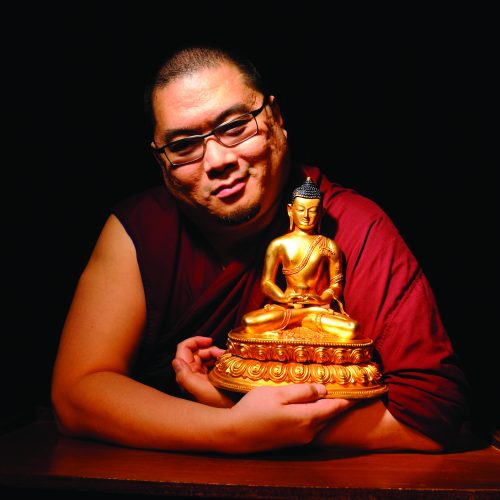
At 9.49pm on September 4th, 2019 according to the Western calendar and on the 6th day of the seventh month of the Earth Boar Year of the Tibetan Lunar Calendar, Rinpoche concluded his earthly Dharmic activities and passed away into parinirvana. Rinpoche remained in thukdam (clear light death meditation) for two days, emerging from his meditations on the morning of September 6th, 2019.
Upon learning of Rinpoche’s passing into parinirvana, disciples, monasteries, friends around the world and upholders of the lineage engaged in extended prayer vigils, reciting Prayer for the Swift Return of His Eminence the 25th Tsem Rinpoche. Composed by the king of our lineage, His Holiness Kyabje Trijang Chocktrul Rinpoche, the prayer is a heartfelt and fervent request for Tsem Rinpoche to swiftly return in an unmistaken incarnation to continue his enlightened activities in this earthly realm.
On September 8th, 2019, after the traditional rites and rituals were performed by monks from Gaden Monastery, Rinpoche’s kudung (holy body) was escorted back home to Kechara Forest Retreat where hundreds had gathered, queuing for up to six hours to have one final audience with their lama.
Over the ensuing three weeks, they would be joined by local Dharma luminaries and government officials, as well as high lamas and senior monks who flew into Malaysia from all over the world just to pay their final respects. These monks would be instrumental in the preparations for the cremation, extensive as they were to befit a true Dharma King. Pavilions were erected at the cremation site, each decorated with brocades, silks, thangkas and Rinpoche’s favourite flowers. But central to all of the preparations was the large, richly decorated and painted funerary stupa, into which Rinpoche’s kudung would be escorted by those closest to him, before the stupa would be set alight with 13 special substances ritually offered into the funerary flames.
As the flames burned, numerous auspicious signs were observed in the sky, in the clouds and in the smoke arising from the sacred fire itself. More signs emerged over the coming days, including in dreams that close students had. Reports would also come in of auspicious signs observed thousands of miles away in India and Nepal, at the time of the funeral itself.
The cremation fire burned steadily for days, until October 7, 2019 when the stupa had sufficiently cooled to be opened. As the dismantling proceeded according to tradition, the most definitive signs of Rinpoche’s spiritual realisations were revealed. Amongst Rinpoche’s ashes and bones were literally hundreds of tiny pearl-like objects, perfectly shaped and white in colour. The lamas immediately recognised them to be precious white relic pills (ringsel in Tibetan or sariras in Sanskrit). These relics were then enshrined, to be used as part of the next steps to create the causes for the return of a lama who was truly one-in-a-million.
While there are those who might lament the missed opportunity to meet Buddha Shakyamuni, in reality, over 2,500 years later, he came to be among us, manifesting as a bodhisattva in South East Asia who, for 53 glorious years, created the outer and inner environment where we might tap into and connect with our own bodhisattvahood.
Rinpoche’s temporary absence will be deeply felt, his passing leaving an indelible imprint on the minds of countless sentient beings. In life, Rinpoche emphasised study and practice of the Lam Rim, 50 Stanzas of Guru Devotion, Eight Verses of Mind Training, and the Wheel of Sharp Weapons. With his passing, Rinpoche leaves behind a legacy of mind training, guru devotion and the Three Principal Paths.
As Rinpoche’s students, we remain forever grateful for having been given the precious opportunity to serve such a rare and precious being as our teacher. Now, more than ever, is time for each of us to start our own journey of many lifetimes, all the while knowing that we are walking in the footsteps of a Buddha. We wait with faith and longing for the swift return of our beloved lama, His Eminence Kyabje Tsem Tulku Rinpoche Tenzin Zopa Yonten Gyatso.
